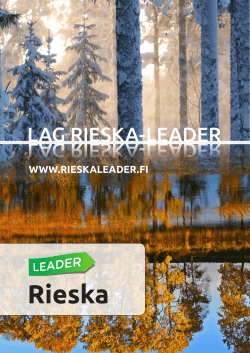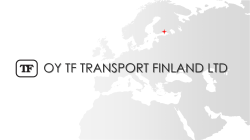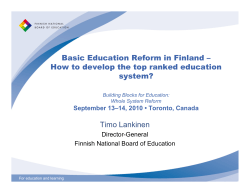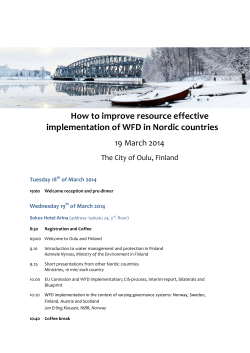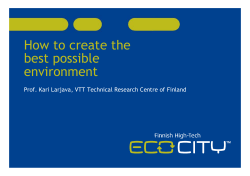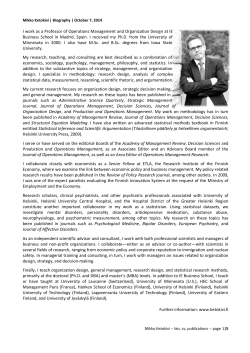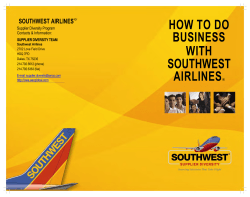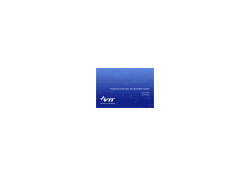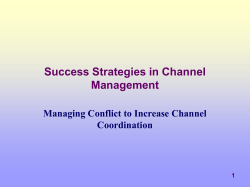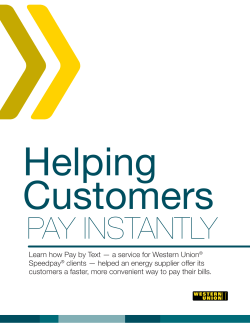
Supply Chain Vulnerability, Risk, Robustness & Resilience Helen Peck, Cranfield University
Supply Chain Vulnerability, Risk,
Robustness & Resilience
Helen Peck, Cranfield University
In Mangan, Lalwani & Butcher, Global Logistics
and Supply Chain Management
John Wiley & Sons [2008]
Finland 2010
Definitions
•
Risk:
– Decision theory – range of possible outcomes & their values, upside gains & downside losses
– Hazard or threat (technological risk; political risk)
– Safety & Engineering: Downside consequences of rational decision (worst case scenario)
•
Supply Chain Vulnerability:
–
–
–
–
–
–
•
What has disrupted operations in the past?
What known weaknesses do we have?
What ‘near misses’ have we experienced?
What would be the effect of a key material shortage?
What would be the effect of the loss of a distribution site?
What would be the effect of the loss of a key supplier or customer?
Robust Strategy:
– Firm able to manage regular demand fluctions regardless of disruption
•
Resilience
– Ability of the system to return to its original (or desired) state after disturbance
Finland 2010
Donald Rumsfeld
• What hasn’t happened is interesting
– There are known knowns
• Things we know we know
– There are known unknowns
• We know that we don’t know
• Y2K
– There are unknown unknowns
• We don’t know we don’t know
• 9/11
• THESE ARE USUALLY THE DIFFICULT MATTERS
Finland 2010
Creeping Crises
• Systematic supply chain disruptions
– Post-9/11 security concerns
– Hurricane Katrina
– Inadequate managerial controls
• Enron (WorldCom; Dutch retailer Royal Ahold; Italian dairy
conglomerate Parmalat Finanziara)
• Barings Bank
– Mitigating legislation
– Need Business Continuity Management, due diligence
• Sarbanes-Oxley
• Basel Accords in International Banking
Finland 2010
Supply Chain wicked problems
• Level 1: Value stream/product/processes
– Flow of work, material, information, money
• Level 2: Asset & infrastructure dependencies
– Fixed & mobile assets
• Level 3: Organizations & inter-organizational
network power dependencies
– Commercial wellbeing, contractual & stakeholder
relationships
• Level 4: Social & natural environment
– Society, economy & natural environment
Finland 2010
Level 1: Process Engineering &
Inventory Management
• Flows within and between organizations
– Underlies lean manufacturing
– End-to-end perspective of agile manufacturing
• RISK MANAGEMENT
– Improved visibility of demand, inventory
– Velocity (reduce likelihood of obsolescence)
– Tight monitoring and control (TQM, 6 Sigma)
• Mastery of process control facilitates
identification, management and elimination of
risk
– But need to consider rest of system
Finland 2010
Level 2: Asset & Infrastructure
dependencies
• Nodes (facilities) & links (roads, trucks, etc.)
• Asset-based RISK MANAGEMENT
• Catastrophes
• IT, supply chain system disruption
• Loss of key skills
– Probability x severity
– Impact on operations of loss of links or nodes
through network modeling
– Mitigating impacts through business continuity
planning
Finland 2010
Level 3: Organization & InterOrganizational Networks
• Financial consequences of events or decisions
• Loss of sole supplier or customer
– Impact on budget or shareholders
– Strategic management
– Conflicts of interest
• RISK MANAGEMENT
–
–
–
–
Partnering
Dual sourcing
Outsourcing
Contractual obligations
• UPSIDE
– Look for competitive advantage in core competencies
Finland 2010
Level 4: Macro-Environment
• Political
– Green movement
– Wars
•
•
•
•
Economic
Social
Technological
RISK MANAGEMENT
– Risk avoidance
– Contingency planning
Finland 2010
Supply Chain Risk Categories
6 sources
CATEGORY
RISK
NATURE
External
Natural disaster, plant fire, disease & epidemics
POLITICAL SYSTEM
“
War, terrorism, labor disputes, regulations
COMPETITOR & MARKET “
Price, recession, exchange rate
Demand, customer payment
New technology, obsolescence substitutes
AVAILABLE CAPACITY
Internal
Capacity cost, supplier bankruptcy
INTERNAL OPERATION
“
Forecast inaccuracy, safety
Bullwhip, agility, on-time delivery
Tradeoff: inventory/fill rate
Quality
INFORMATION SYSTEM
“
System breakdown
Distorted information
Integration
Viruses/bugs/hackers
Finland 2010
Supply Chain risk management process
P. Chapman, M. Cristopher, U. Juttner, H. Peck, R. Wilding,
Logistics and Transportation Focus 4:4 [2002] 59-64
• Risk Identification
– Uncertainties: demand, supply, cost {quantitative}
– Disruption: disasters, economic crises {qualitative}
• Risk Assessment
–
–
–
–
–
Political
Product availability
Capacity, demand fluctuation
Technology, labor
Financial instability, management turnover
• Risk Avoidance
– Insurance
– Inventory buffers
– Supply chain alliances, e-procurement
• Risk Mitigation
– Product pricing, other demand control
– Product variety
– VMI, CPFR
Finland 2010
Risk Reduction Strategies
C.S. Tang
Journal of Logistics: Research and Applications 9:1 [2006] 33-45
1.
2.
3.
4.
Identify different types of risk
Estimate likelihood of each event
Assess potential loss from major disruption
Identify strategies to reduce risk
Finland 2010
Robust Strategies
Tang [2006]; Khan & Burnes [2007]; Wagner & Bode [2008]; Manoj & Mentzer [2008]
Strategy
Examples
Postponement
Standardization, commonality, modular
design – delay point of product
differentiation
Nokia, Xilinx,
Benneton
Strategic stock, buffers
Safety stock for key items
Toyota, CDC
Flexible supply base
Sole sourcing through multiple suppliers
HP
Make-and-buy
Outsource
HP; Zara
Economic supply incentives
Pay premium
Flu vaccine
Flexible transportation
Multi-modal transportation
Dynamic pricing, promotion
Influence demand through price
Dell
Dynamic assortment planning
Influence demand by display, location
Groceries
Silent product rollover
Slowly leak new products
Zara, Swatch
Finland 2010
Risk Context
• SUPPLY
– Political risk (acts of God, acts of man)
• DEMAND
– Changes in demand from
•
•
•
•
Loss of reputation for quality
Loss of technological or design competitive edghe
Unpredictable customer preferences
Economic recession
• CONTEXTUAL RISKS
–
–
–
–
Cultural differences
Environmental risk
Regulations risk
Exchange rate risk
Finland 2010
Samsung Electronics ERM
MS Sodhi, S Lee
Journal of the Operational Research
Society 58 [2007] 1430-1439
Finland 2010
Samsung Risk Management
• Supply chain risks mitigated by
– Keeping inventories low
– Keeping capacity flexible
– Redundant suppliers for non-core components
– Use of information technology
Finland 2010
Specific Risk-mitigation Steps
Supply related risks
RISK
MITIGATION
Mergers & acquisition threats
Close relations with suppliers (IT integration)
Acts of God, war, terrorism, sanctions
Multiple locations for plants & suppliers
Political risk
Multiple locations for plants & suppliers
Capacity risk
Flexible capacity – multi-platform lines
Single sourcing
Limit to core-components only (30%)
Intellectual property risk
Internal manufacturing for all core
technologies;
Close relations with suppliers
Supplier delays
Global control center; Integrated SAP;
Local suppliers for non-core components;
Supplier plants integrated with Samsung’s
Finland 2010
Specific Risk-mitigation Steps
Demand related risks
RISK
MITIGATION
Worldwide recession
Samsung Economic Research Institute research
Reputation risk
Name recognition; Use reputable auditors
Technology change risk
Heavy R&D investment
Customer preference change
CRM center
Forecast risk
Monitor retail store inventories with Rosetta-Net
Receivables risk
Use hard currency in risky countries
Finland 2010
Specific Risk-mitigation Steps
Contextual risks
RISK
MITIGATION
Environmental risk & compliance Environment team created 1993;
Proactive anticipation of regulations
Regulation compliance
Use of reputable auditors
Exchange rates
Use of futures
Euros used in Central & Eastern Europe
Financial risk
Strategic restructuring;
Transparent financials
Systems risk
Data center backed up in different locations
Cultural differences
In-house training
Finland 2010
Rolls Royce Early Supplier Involvement
G.A. Zsidisin, M.E. Smith, The Journal of Supply Chain
Management [Fall 2005] 44-56
• Aerospace Division
– Industry driven by cost, reliability
– Extensive R&D
• Rolls Royce typically 3-4 years for new product
• Industry averaged 10 to 20 years
– Supplier-provided components 65-80%
Finland 2010
Rolls Royce ESI process
1.
2.
3.
4.
5.
6.
7.
8.
9.
10.
11.
12.
13.
14.
15.
16.
Establish customer need
Identify EDI project
Develop component target costs
Prepare ESI project & milestones
Inform business units
Determine commodity breakdown
Develop potential supplier list
Develop business objective
Supplier workshops
Review expectations with suppliers
Conduct ESI workshop
Value engineering, evaluate prices & technical
Evaluate & score suppliers
Make recommendations
Inform suppliers
Develop working agreements & implement
Finland 2010
ESI Benefits
•
•
•
•
•
•
•
Reduced threat of excessive costs
Reduced legal liabilities
Improved quality
Relaxed supplier capacity constraints
Reduced product development time
Better able to handle product design changes
Better control over supplier leadership issues
Finland 2010
Risk of Disintermediation
J.F. Mills & V. Camek, International Journal of Physical distribution &
Logistics Management 34:9 [2004] 714-727
• Motokov UK Ltd
– British importer/distributer in tractors, tires
– TRACTORS
•
•
•
•
Landini – Italian agricultural machinery manufacturer
Initially marketed through Edwards Ltd tractor dealership
Replaced with exclusive dealership (Motokov) for 3.5 years
Replaced with newly formed Landini UK distribution
– Landini had damage settlement expenses when
terminated with disintermediated firms
– Felt they obtained better control, worth expense
Finland 2010
Tires
• Motokov dealt with Matador Tyres
– Exclusive UK distributors
– Tires frangible, low margin
• Matador disintermediated Motokov in early 1990s
• 1994 Motokov rebuilt business around Barum tires (Czech)
• Barum acquired by Continental, who reconfigured their supply
chain
• 1995 Motokov dropped Barum, returned to Matador
– No longer sole importer
• 2002 Matador acquired large customers wanting reduced costs
– Source producer dealt directly with customers
– Motokov too small, disintermediated
Finland 2010
Tractors
• Zetor a Czech tractor producer, founded 1946
• 1960s supplied UK through Motokov
• Late 1990s Zetor had financial problems
– Full capacity, but no profit
– 1998 to 2000 halted production
• Before 1998 Motokov sold about 600 Zetor
tractors per year
– 2000 down to 200
– Zetor would benefit from buying out Motkov, reduce
costs
Finland 2010
© Copyright 2025
